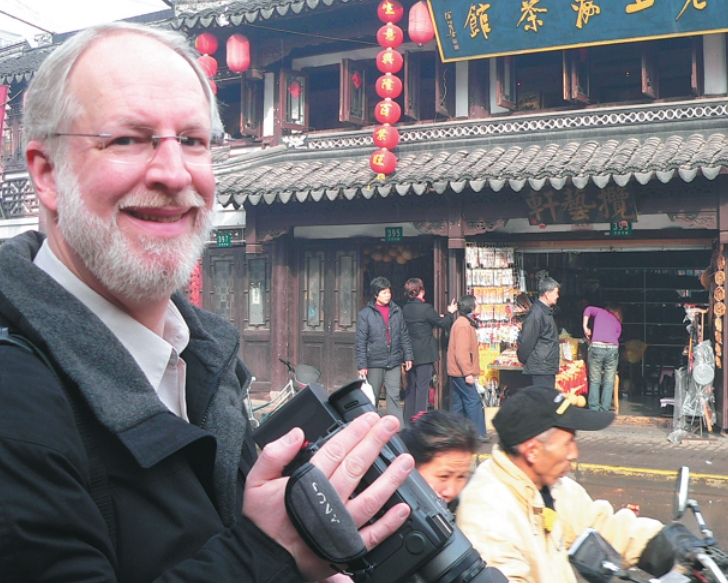Emmy winner shines light on Flying Tigers
Documentary tells stories of veterans famous in China but forgotten at home
By Minlu Zhang in New York | China Daily | Updated: 2024-03-23 07:35

A three-time Emmy Award-winning film producer is telling the stories of World War II veterans from the United States who "are famous in China but forgotten at home".
In October 2023, during his visit to China for a documentary screening, producer Bill Einreinhofer noticed continuous coverage of two elderly US military veterans on Chinese TV. They appeared on both local and national television, known to almost every Chinese person. However, Einreinhofer, a TV producer, had never heard of them.
They were Harry Moyer, 103, and Mel McMullen, 98. The two were part of a delegation visiting China to honor US military pilots who helped China battle Japan during the war.
In 1941, before the US was drawn into the war by the Japanese attack on Pearl Harbor, a group of US military officers resigned their commissions to volunteer and bolster China's air force.
In his new documentary Valor and Memory, set to be released on the upcoming Veterans Day in the US, Einreinhofer explores the shared experience between the two countries during the war.
"It's a story that has been told a lot in the US, but not recently. When I asked my students who the Flying Tigers were, they thought it was a rock 'n' roll band. They are remembered in China, but they're forgotten at home," said Einreinhofer, who is also the emeritus chair of the broadcast journalism department at the New York Film Academy.
"I want to remind Americans who these guys were, what they did, and why what they did was important. At the same time, I want an American audience to know they didn't fight alone, because they literally were fighting side by side with Chinese pilots," he said.
The Flying Tigers began to arrive in China in 1941, with about 100 military pilots from the US Navy, Army Air Corps and Marine Corps, along with about 200 support crew. About a dozen of them were Chinese Americans, as the military needed their Chinese linguistic and cultural skills, according to Einreinhofer.
The Flying Tigers gained recognition with a winged Bengal Tiger logo designed by Walt Disney, and the term Flying Tigers debuted in Time magazine a week after their first combat in China on Dec 20, 1941.
In 1942, some Chinese pilots began to come to the US to train so they could fly fighter aircraft and bombers, and then they would return home to defend their country, said Einreinhofer.
Data shows that more than 2,000 Flying Tigers airmen gave their lives during the war.
Shared history
"Let's face it, America and China, we have a shared history. It's a very contentious history. We often disagree, even when we were allies back during World War II, we disagreed, and the cultures are different. But at the end of the day, people are people," said Einreinhofer.
Audiences today still will "respond to stories that have strong human characters, people who are doing interesting things, people who are doing important things. And for me, China is an unending source of fascinating people',' he said.
The documentary comes as the current relations between China and the US have deteriorated.
"This is an incredibly exciting story to tell, especially right now, because the clock is ticking. These men are elderly. ... We need to tell the story now while some of them are still around, to realize how much they are appreciated," he said.
Einreinhofer, who has been filming documentaries in and about China for more than 30 years, said there are certainly profound and deep differences between the US and China.
"And primarily, those differences are between the governments. But on a person-to-person level, I think there's a lot of commonality."
He cited the Flying Tigers as an example of such personal exchanges. For the Chinese military pilots who went to the US for training, each was paired with a US pilot.
Lot of commonality
The US pilots helped them learn and adjust. At the same time, he said, their US buddies learned from the Chinese that much of what they knew about China was incorrect.
"When you're looking at the world today, the US and China, they are portrayed as rivals. But that's just one area of conversation. There are so many other areas where there is a commonality between the American people and the Chinese people.
"And I really think it is through person-to-person communication that each side starts to get to know the other. And that's critical. Because however deep our differences may be, I think people on both sides, they don't want a war. They don't want chaos. That's not their goal," he said.
In the early 1990s, he had traveled to China as the executive producer of a weekly science health and technology series that aired on the Public Broadcasting Service to film China's space exploration.
One of the biggest challenges Einreinhofer faced was "cultural differences", he said. Even today, he still can't read his Chinese name on his business card.
"There were so many cultural differences, and there were all the language differences. But in the end, the experience was very positive. I felt I had learned a whole lot, not just about the subject that I was studying, but about China and life in China," he said.
Decades after the story of the Flying Tigers, Einreinhofer continues to feel the bond between people from the two countries working side by side, just as the Flying Tigers had experienced.
In China, where networks are key, Einreinhofer worked effectively by hiring local crews despite having no personal connections there. This approach not only cuts costs but also taps into their expertise in language, customs and networks, he said.
"It was through them that I really started to get an idea of what it was like to be living in China. And it's the sort of thing you can't read in a book, you're not going to get it in a magazine article.
"These people were incredibly generous, and in sharing their lives with me. And in doing so, I got a priceless education. And it really helped to make me unique as an American producer and American director, who at least has a degree of understanding of what is going on around me when I'm in China," he said.
minluzhang@chinadailyusa.com
























